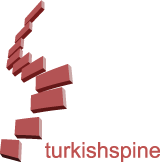ABSTRACT
Cervical spinal stenosis (CSS) is a pathology typically seen in males over the age of 65 years, at C5-6 and C6-7 distances, often due to a decrease in the cervical canal diameter, resulting from the degenerative process and the formation of a secondary neural compression. Although degeneration of the cervical spinal elements is the primary pathologic lesion in CSS, secondary compression of the spinal cord or spinal vascular structures is responsible for the emergence of myelopathy symptoms. Risk factors for normally localised CSS include increasing age, male gender, disc degeneration, loss of vertebral height due to ageing (with trauma or osteoporosis), posterior longitudinal ligament calcification and the presence of a congenital anomaly (Congenital CSC, Klippel-Feil Syndrome). Clinically, progressive myelopathic complaints are prominent depending on the degree of stenosis. Diagnosis is made by measuring the anteroposterior diameter of the cervical canal radiologically. Treatment is by surgical decompression with or without fusion, in patients having progressive clinical symptoms, with radiological evidence of a narrow canal and the existence of neurological compression. In this report, two patients without systemic/rheumatologic concomitant disease and congenital predisposing factors, who were operated for isolated C1 narrow canal were discussed with a review of the literature.
INTRODUCTION
Cervical spinal stenosis (CSS) is a progressive degenerative process which occurs as a result of fragmentation of intervertebral discs, decreased fluid content and collapse and ongoing degeneration of the spine(1). Although degeneration of the cervical spinal elements is the primary pathologic lesion in the CSS, secondary compression of the spinal cord or spinal vascular structures is responsible for the emergence of myelopathy symptoms(1,2). CSS is a natural result of ageing. It occurs in 10% and 95% of patients at 25 and 65 years, respectively(3). Decreased sagittal diameter of the cervical canal is the main factor of the primary degenerative process in CSS. The clinical course is usually insidious and progressive. It often begins with stiffness and axial pain in the neck, progressing with pain and strength loss in the arms, numbness in the hands, loss of dexterity and sensation, gait imbalance, weakness and stiffness in the legs and rarely, sphincter control loss and urinary incontinence over time(4). Diagnosis is made by the presence of progressive myelopathic complaints and when the anterior-posterior diameter of the cervical canal, which is normally 34.5 mm on average, is less than 10 mm on radiological examination. In patients with radiologically diagnosed progressive deficit and myelopathic complaints, treatment includes surgical decompression with or without fusion. In this case report, two patients without systemic/rheumatologic concomitant disease and congenital predisposing factors, who were operated for isolated C1 spinal stenosis were discussed with a review of the literature.
CASE REPORT
Case 1: A 53-year-old male patient with no systemic concomitant disease was admitted to our clinic with increasing numbness in his hands and gait disturbance for the past 3 years. On neurological examination, the patient had no significant motor sensory deficits, Hoffman positivity was found on the right and his JOA score was 14. The anteroposterior diameter of the cervical canal measured on preoperative cervical magnetic resonance imaging (MRI) was 6.1 mm. The preoperative cervical computerised tomography (CT) and MRI of the patient showed thickening and hypertrophy of the posterior elements at the C1 level and increased cord signal in T2 sequences compatible with myelomalacia (Figure 1, 2). The patient was diagnosed with C1 spondylotic canal and administered a C1 posterior decompression, C1-C2 instrumentation and fusion surgery. After 4 years of follow-up, no additional neurological deficit or radiological spondylotic canal was detected (Figure 3, 4, 5).
Case 2: A 67-year-old male patient with no systemic concomitant disease presented to our clinic with complaints of weakness in the hands, feeling of electric shock in the arms, inability to use the hands, inability to walk without support with increasing intensity for the past 2 years and urinary-faecal incontinence for the past 8 months. The patient’s neurological examination revealed a marked decrease in fine motor abilities on the right with a strength of 2/5 in the right upper extremity, spasticity, Romberg positivity, hyperactivity in deep tendon reflexes, Hoffman and Lhermitte’s signs and clonus positivity on the right; JOA score was 9. The anteroposterior diameter of the cervical canal was 7.2 mm on the patient’s preoperative cervical MRI. The preoperative cervical MRI showed increased cord signal in T2 sequences compatible with myelomalacia at the C1-C2 level (Figure 6). The preoperative cervical CT of the patient did not show thickening and hypertrophy of the posterior elements at the C1 level (Figure 7). Upon diagnosis of the C1 spondylotic canal on the preoperative cervical MRI, C1 and C2 posterior decompression, C1-C2 instrumentation and fusion surgery were performed. After 8 years of follow-up, no additional neurological deficit or radiological spondylotic canal was detected (Figure 8, 9, 10).
DISCUSSION
The symptomatic degenerative process begins with the formation of osteophytes at the C5-6 and C6-7 distances, where movement is greater and therefore, CSS is most common(1,5). Subsequently, C4-5 and C3-4 distances are typically affected(6). After progressive degeneration, the spinal canal diameter, which normally varies between 17-18 mm from the C3-C7 vertebrae decreases and when it falls below 10 mm as defined in CSC, the clinical picture emerges after neuronal compression(7). The mean anterior-posterior diameter of the cervical canal at the distance of C1-C2 is 34.5 mm and because of its rarity, there is no clear canal diameter defined in the literature for its clinical formation in this distance. When the diameter of the spinal canal falls below 10 mm irrespective of the distance, an absolute narrow canal is considered and myelopathic complaints are observed. Consistent with the literature, both cases had severe myelopathic complaints secondary to decrease in the canal diameter, which were of greater intensity in the second case.
When the affected cervical segments are examined in CSS, spondylotic changes occurring in the cervical spine alone, most commonly observed between the C3 and C7 cervical vertebrae, have a frequency of 15%, whereas the frequency of spondylotic changes occurring at multiple levels is 60-85%(8). The presented cases had a rare C1 segment and single level involvement, without any predisposing factor and there was no case with similar features when the literature was reviewed.
Risk factors for normally localised CSS include increasing age, male gender, disc degeneration, loss of vertebral height due to ageing (with trauma or osteoporosis), posterior longitudinal ligament calcification and the presence of a congenital anomaly (Congenital CSC, Klippel-Feil Syndrome)(9,10). Upper distance (C1-C2) cervical region involvement is typically seen in association with the presence of systemic connective tissue diseases such as rheumatoid arthritis. Spinal canal diameter is narrowed and myelopathic complaints develop following extension of the pannus formation, which occurs after recurrent acute synovitis attacks, from around the dens into the spinal canal(11). In post-mortem examinations conducted on these patients, the upper cervical region was involved at a rate of 59-80% and it was found that the cause of death was spinal cord compression in seven (63.6%) of 11 cases(12).
We performed a literature search in the PubMed Database for “C1 Stenosis” and also cross-referenced articles. There are some predisposing factors of C1 spinal stenosis and Table 1 outlines the literature review of CSS diagnosed in the upper segment (C1). Isolated pure atlas hypoplasia is rare, while fissures and segmentation defects are relatively common. Arch anomalies of the atlas rarely causes compression, since they usually increase the canal space. Another anomaly that may be associated with hypoplasia and canal stenosis is an ossified transverse ligament, leading to chronic and progressive myelopathy. Some syndromic diseases that may be associated with hypoplasia of the atlas include Down syndrome, Turner syndrome, Morquio disease, ankylosing spondylitis, achondroplasia, gonadal dysgenesis and congenital spondyloepiphyseal dysplasia. A congenital malformation presents with clinical symptoms relatively later in life (as opposed to at birth or during childhood). Symptoms generally indicate superimposed age-related degenerative changes, such as ligamentum flavum buckling, pannus behind the dens or synovial cyst formation. Due to this reason and depending on the degree of congenital stenosis, the age of presentation of C1 stenosis may vary from small children to older adults.
When the predisposing risk factors for CSS were examined, there were no significant findings except for male gender and advanced age in the cases discussed. There was no congenital narrow canal or connective tissue disease.
In conclusion, new clinical and radiological narrow canal findings were not present after 4 and 8 years of follow-up. The cases are considered as rare cases due to both the development without the presence of predisposing factors and the distance involved being limited to the C1 level. As a result, it should be borne in mind that CSS can also be seen at the C1 level in the absence of predisposing factors, although rare.



